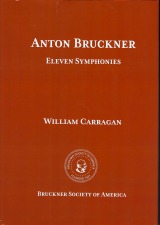|
|
Carragan, William: Anton Bruckner: Eleven Symphonies |  | |
222 pages
Bruckner Society of America
2020
ISBN 978-1-938-911-59-0
Below is a review to the book written by Thomas Liebnitz, past director of the Music Division of the Austrian National Library in Vienna:
Anyone who works in the field of Bruckner research knows William Carragan. He is not only Vice President of the Bruckner Society of America, but has also been actively involved in the scholarly preparation of the Bruckner Complete Edition for many years. Certainly his intention to write this book is due to this intensive study of the musical texts.
The user must not expect simple, easy-to-consume reading. Carragan’s aim is to grasp the musical structures in Bruckner, especially the problem of the different versions of the symphonies. And so a study book was created rather than a reading book. Anyone who intends to use this book would do well to have the score of the respective work ready, so as to understand Carragan’s observations whereby the author endeavors to give the user the best possible help. Not only do numerous music samples underline what has been said, but there is also a large number of audio samples that can be conveniently called up on a corresponding website with the help of QR codes.
Which works are we talking about here? The author rightly speaks of “eleven symphonies”. Bruckner’s symphonic cosmos also includes the early “Study Symphony” in F minor, which he wrote at the end of his studies with Otto Kitzler, as well as the “Nullified Symphony” in D minor, his actual third which he officially declared “invalid” but carefully kept the manuscript. Hans-Joachim Hinrichsen also included these two not-officially-numbered works in his monograph on Bruckner’s symphonies. Carragan goes even further: he includes the string quintet from 1879 and starts with the string quartet in C minor from 1862 and the overture in G minor from the same year, bringing up the movement concepts of the “pre-symphonic” Bruckner.
In the foreword to the book, Benjamin Korstvedt, President of the Bruckner Society of America and himself editor in the Bruckner Complete Edition, summarized Carragan’s intentions very precisely: “He is not at all interested in offering easy, categorical identifications of the ‘best’ or ‘most authentic’ versions. Rather he seeks to present a full picture of the revisions, modifications, and changes that Bruckner made to each of his symphonies. The result is a unique and enthralling picture of an exceptional musical mind at work across some three decades.” We unreservedly endorse Benjamin Korstvedt’s comment and wish the book readers who will make the arduous but rewarding journey with William Carragan to get to know the characteristics of Bruckner's musical language on the basis of the musical texts themselves.
|
|
|
 ABruckner.com
ABruckner.com